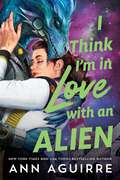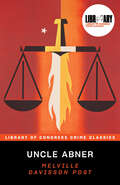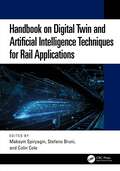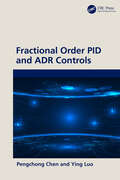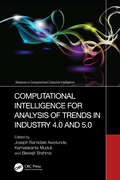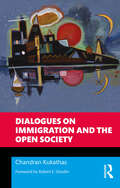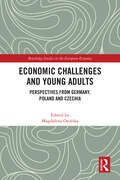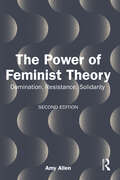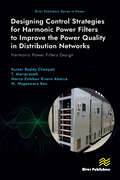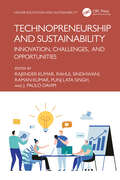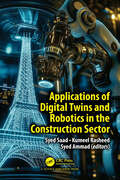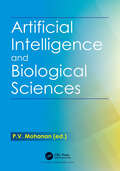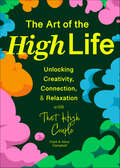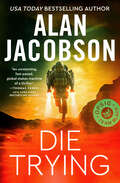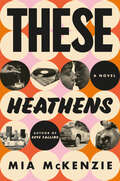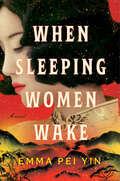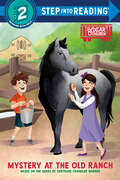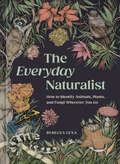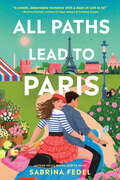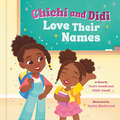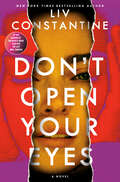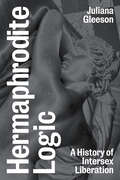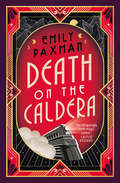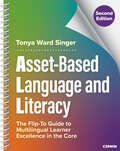- Table View
- List View
I Think I'm in Love with an Alien
by Ann AguirreGalaxy Quest meets Roswell in this quirky sci-fi rom-com from New York Times and USA Today bestselling author Ann Aguirre.He's stranded. He's desperate. He's not looking for love.Alien Tamzir Jaarn, a.k.a. Seeker, is paying the price for risking an illicit holiday on an interdicted planet. His ride off-world never showed, and he's been stranded on Earth for nearly a year. His gear is breaking down, food is becoming a problem, and if his camouflage unit fritzes, he'll wind up in a government lab.But he's met some cool humans online, and they've invited him to the biggest space-themed convention around. Why not make memories with them while he figures out how to get home?Space Con or bust!She's nerdy. She's flirty. She's ready for romance.Jennette Hammond is an endearing weirdo, voted most likely to bang an alien in high school. Her house is full of gray man collectibles, adorable tentacle monsters, and yes, in college, she volunteered for a SETI-type program. Not that she's ever had any close encounters of the sexy, alien kind. Heck, she's never even been able to convince anyone to attend Space Con.But that's about to change. Finally, she has online friends who have agreed to go, and it will be a romp to remember—and she'll finally put a face to the name of her longtime crush, Seeker.When alien meets adorkable, they're destined for an out-of-this-world affair…
Uncle Abner (Library of Congress Crime Classics)
by Melville Davisson PostFirst published in 1918, this collection of tales of Abner's investigations, told by his nephew and chronicled by the prolific Melville Davisson Post, was hailed as the most important volume of American crime fiction since the work of Edgar Allan Poe."It is a world…filled with the mysterious justice of God!" The titular Uncle Abner is a man with extraordinary powers of observation, a close reader of the Bible, and a towering code of morality, and he does not shy from taking matters into his own hands when the law is too slow or too blind to dispense justice. A landowner in nineteenth-century West Virginia, Abner is a fountainhead of God's wisdom and justice for the territory. Post's stories and novels were highly popular, appearing in national magazines and book form. Though the stories are little read today, there is nothing old-fashioned about the terrible crimes committed in the backwoods or Abner's extraordinary skills as an observer of men and evil.
Handbook on Digital Twin and Artificial Intelligence Techniques for Rail Applications
by Maksym Spiryagin Colin Cole Stefano BruniWith contributions from experts from around the world, this handbook aims to systemize the existing experience and knowledge that can be used to the development of more efficient and controlled railway systems. As a result, this handbook showcases the modern methods, methodologies and frameworks for the development of DT and AI architectures and apparatus in the area of the existing railway systems and transport engineering tasks. The chapters cover such varied and specialized topics as the processes related to the transformation of a physical twin into a digital twin; the application of data-driven and physics-based simulation approaches in the development of digital twins; asset management application tasks with the implementation of DT and AI; and the experimental and field applications of the DT and AI concepts and technologies in railway transport system design and predictive maintenance tasks.Handbook on Digital Twin and Artificial Intelligence Techniques for Rail Applications is essential reading for engineers, practitioners and researchers involved in the development of railway transport and transit systems.
Fractional Order PID and ADR Controls
by Ying Luo Pengchong ChenThis book explores the design and analysis of fractional-order and active disturbance rejection control, examining both the theoretical foundations and their practical applications.It covers fractional-order proportional-integral-derivative (PID) control, fractional-order active disturbance rejection (ADR) control, and the combined fractional-order PID-ADR control. The book begins with an analysis of the three-parameter fractional-order PID controller, demonstrating its application to the permanent magnet synchronous motor (PMSM) speed servo system, due to its comprehensive inclusion of proportional, integral, and differential elements. It then delves into active disturbance rejection control and periodic disturbance compensation, comparing the performance of each controller based on various parameters. This comparison enables readers to critically evaluate the advantages and limitations of each approach before implementation. Offering a thorough guide to fractional-order and active disturbance rejection control, the book also includes numerical methods for assessing and developing these systems.The book will be of particular interest to professionals working with numerical methods, fractional-order systems and control, PID controller, active disturbance rejection, control design, and production and is especially relevant to those in mechanical, industrial, and electrical engineering.
Computational Intelligence for Analysis of Trends in Industry 4.0 and 5.0 (Advances in Computational Collective Intelligence)
by Kamalakanta Muduli Biswajit BrahmaIndustry 4.0 and Industry 5.0 applications will revolutionize production, enabling smart manufacturing machines to interact with their environments. These machines will become self-aware, self-learning, and capable of real-time data interpretation for self-diagnosis and prevention of production issues. They will also self-calibrate and prioritize tasks to enhance production quality and efficiency.Computational Intelligence for Analysis of Trends in Industry 4.0 and 5.0 examines the trends in applications that merge three key disciplines: Computational Intelligence (CI), Industry 4.0, and Industry 5.0. It presents solutions using industrial Internet of Things (IIoT) technologies, augmented by CI-based techniques, modeling, controls, estimations, applications, systems, and future scopes. These applications use data from smart sensors, processed through enhanced CI methods, to make smart automation more effective.Industry 4.0 integrates data and intelligent automation into manufacturing, using technologies like CI, Internet of Things (IoT), IIoT, and cloud computing. It transforms data into actionable insights for decision-making and process optimization, essential for modern competitive businesses managing high-speed data integration in production processes. Currently, Industry 4.0 and Industry 5.0 are undergoing significant transformations due to advances in applying artificial intelligence (AI), big data analytics, telecommunication technologies, and control theory. These trends are increasingly multidisciplinary, integrating mechanical, control, and information technologies. However, they face technical challenges such as parametric uncertainties, external disturbances, sensor noise, and mechanical failures. To address these issues, this book examines trends such as CI technologies as fuzzy logic, neural networks, and reinforcement learning and their application to modeling, control, and estimation. It also covers recent advancements in IIoT sensors, microcontrollers, and big data analytics that further enhance CI-based solutions in Industry 4.0 and Industry 5.0 systems.
Dialogues on Immigration and the Open Society (Philosophical Dialogues on Contemporary Problems)
by Chandran KukathasAfter some friendly pestering from six of his students curious about his thinking about immigration, a philosophy professor invites them to present their own ideas to him over a series of meetings throughout the term. This book is about their conversations.These dialogues introduce the reader to the most important ethical and political questions about immigration. They begin by considering the claim that significant levels of immigration pose a threat to the very civilization of the West, where the immigration issue is a particularly vexed one. The chapters that follow consider the economics of immigration, whether or not the state is justified in its efforts—or even obliged—to control immigration, and whether everyone has a right to move or if only refugees can make so strong a claim. The final chapter considers the implications of a philosophy of immigration on the ideal of an open society. Throughout the book, there is a strong emphasis on addressing the conceptual questions that are vital for making any headway in understanding practical issues. What is a refugee? What are rights? What is an open society? Indeed, what is immigration?Key Features: Written as a friendly engagement between six thoughtful but skeptical students who hold a variety of views, and a philosophy professor, who insists he’s just trying to work out the answers with their help rather than convince them of one right answer; Engages with the immigration debates in philosophy, economics and politics, without presupposing any specialist knowledge; Includes discussion of the historical and institutional aspects of immigration, so the conversation is never simply about abstract or hypothetical cases; Concludes with a substantive theory about how to think about immigration and the free society to prompt further reflection.
Economic Challenges and Young Adults: Perspectives from Germany, Poland and Czechia (Routledge Studies in the European Economy)
by Magdalena OsińskaIn recent years, there has been an unprecedented shift in the attitudes of young individuals towards the key economic issues they encounter as they embark on their adult lives. Sociologists have identified two distinct generations, namely Generation Y and Generation Z, which exhibit behaviours contrary to those of their parents and older generations. The reasons behind these shifts are shared across European countries, where these generations have experienced lives characterized by peace, cultural diversity, globalization, economic stability, relative economic and social well-being, as well as parental care and education.Addressing a gap in the economic literature, this book uniquely bridges the current understanding of youth with empirical evidence specific to Central and Eastern European Countries, represented by Poland and Czechia. Germany was taken as an example of a Western European Country. The novelty lies in identifying the contemporary trends and determinants shaping the decision-making process of young adults regarding the labour market, savings and investments, job satisfaction, retirement, and sustainable consumption. The book draws on a theoretical foundation from both economic and sociological perspectives. The book comprises ten interconnected chapters, each contributing to the central theme of youth intentions and attitudes toward economic/financial issues. The summary is presented from the perspective of contemporary megatrends.The target audience includes students and researchers in fields related to contemporary economic challenges—such as economics, psychology, and sociology. Given the challenges faced by young adults from post-socialist states, implementing the policy recommendations in the book may contribute to reducing the gap between them and their counterparts in Western European countries. Institutions involved in social policy, including both non-governmental organizations and public entities, will also find the policy implications to be of interest.
The Power of Feminist Theory: Domination, Resistance, Solidarity
by Amy AllenIn this new second edition of The Power of Feminist Theory: Domination, Resistance, Solidarity, Amy Allen diagnoses the inadequacies of previous feminist conceptions of power, and draws on the work of a diverse group of theorists of power, including Michel Foucault, Judith Butler, bell hooks, and Hannah Arendt, in order to construct a new feminist conception of power.The conception of power developed in this book enables readers to theorize domination, resistance, and solidarity, and, perhaps more importantly, to do so in a way that illuminates the interrelatedness of these three modalities of power. The new edition of this foundational text includes substantial new material on intersectionality and power, transnational feminism and power in relation to homonationalism and neo-imperialism, and empowerment feminism. It addresses important criticisms of Foucault, Arendt, and Butler that have been raised by Black feminists, critical philosophers of race, postcolonial theorists, and Marxists.The Power of Feminist Theory: Domination, Resistance, Solidarity is an essential text for students engaging with feminist analyses of power, feminist theory and feminist political thought.
Designing Control Strategies for Harmonic Power Filters to Improve the Power Quality in Distribution Networks: Harmonic Power Filters Design (River Publishers Series in Power)
by T. Mariprasath Kumar Reddy Cheepati Marco Esteban Rivera Abarca M. Nageswara RaoIn today’s complex and interconnected electrical power systems, maintaining high power quality is crucial for efficient operation and reliability. This book delves into the intricacies of power quality issues, with a special focus on harmonics and their mitigation through advanced filter design and control strategies. It is tailored for both professionals and students in electrical engineering, power systems, and power electronics. It offers a detailed exploration of the following key topics: Fundamentals of power quality: Understand the basic concepts of power quality, its importance, and the common issues encountered in modern distribution networks Harmonic analysis: Learn about the sources of harmonics, their effects on electrical systems, and the methodologies for their analysis Filter design techniques: Discover various types of harmonic filters, including passive, active, and hybrid filters, and the principles behind their design Control strategies: Gain insights into advanced control techniques for harmonic filters, focusing on improving system stability, efficiency, and performance Future trends and innovations: Stay ahead with the latest developments and future trends in harmonic filtering and power quality improvement Written by leading experts in the field, this book combines theoretical foundations with practical insights, making it an essential resource for anyone looking to deepen their understanding of power quality and harmonic filtering. Whether you are an academic, a practicing engineer, or a researcher, this book provides the knowledge and tools needed to tackle the challenges of modern power distribution networks and ensure high-quality power delivery.
Technopreneurship and Sustainability: Innovation, Challenges, and Opportunities (Higher Education and Sustainability)
by J. Paulo Davim Raman Kumar Rahul Sindhwani Punj Lata Singh Rajender KumarTechnopreneurship is an advanced version of entrepreneurship that incorporates cutting-edge technologies from AI to big data into entrepreneurial activities and leads to innovative solutions to problems that previous solutions have failed to sustain in the long term. This book explains the fundamentals of developing and establishing a small one-person business or a large organization, building technological solutions, and performing effectively and efficiently. It covers all aspects of an entrepreneurial journey, guiding readers from the startup stage, growing a business, sustainability, and clarifies the role of technopreneurship as a tool to enhance sustainability in today’s entrepreneurial ventures.Features Explains the theory and the practice of entrepreneurship in today’s technological era Presents technological developments, their implementations, and the potential outcomes of technology used in entrepreneurial activities Covers sustainability and the role of technologies to achieve sustainable development goals associated with different ventures Discusses ways to minimize failures of entrepreneurial ventures especially in startups Includes real-life case studies focused on today’s problems and solutions This book is ideal for undergraduate and graduate students taking courses in Entrepreneurship and Startup as well as business consultants and business owners in any field.
Applications of Digital Twins and Robotics in the Construction Sector
by Syed Saad Syed Ammad Kumeel RasheedThis book provides insights to the lay person as well as the experts who are actively enabling these changes in the construction industry. The book explores digital twins and robots in the construction sector, and how they are revolutionizing this field. It comprises chapters that begin with the basics before going upstream. Digital Twins are important in the planning and design of projects where, real-time simulation, visualization and data-driven decision-making are done. Furthermore, robotics play a significant role in on-site execution, thus automating construction operations, and guaranteeing accuracy and safety. The book discusses the harmony of digital twinning and robotics, showing that these two are complementary with regard to enhancing efficiencies on-site, in monitoring progress and live control.Applications of Digital Twins and Robotics in the Construction Sector covers the current applications of these technologies and forecasts future applications, exposing readers to breakthrough innovations transforming this field. It aims inform all readers, expert or simply interested and inquisitive about digital twins and construction robots’ transformation.
Artificial Intelligence and Biological Sciences
by P. V. MohananAdvancements of AI in medical and biological sciences have opened new ways for drug development. Novel therapeutic molecules and their target action can be easily predicted and can be modified. AI helps in disease detection and diagnosis faster. The breakthrough of AI is made especially in the area of personalized precision medicine, host-pathogen interaction and predictive epidemiology. These approaches could help in faster decision-making with minimal errors that can improve risk analysis, especially disease diagnosis and selecting treatment strategy. In agricultural practices, an exact combination of fertilizers, pesticides, herbicides, soil management, water requirement analysis, yield prediction and overall crop management can be modified by implementing AI interventions. AI could provide a better improvement in agriculture, medical research, pharmaceuticals and bio-based industries for a sustainable life.The key features of this book are: AI in medical Sciences, biotechnology and drug discovery; Application of AI in Digital Pathology, cytology and bioinformatics; Overview of AI, Machine Learning and Deep Learning; Impact of Artificial Intelligence in Society; Artificial Intelligence in Pharmacovigilance; and Ethics in Artificial Intelligence. The volume aims to comprehensively cover the application of AI in biological sciences. It is a collection of contributions from different authors who have several years of experience in their specific areas. The book will be useful for pharma companies, CROs, product developers, students, researchers, academicians, policymakers and practitioners.
The Art of the High Life: Unlocking Creativity, Connection, & Relaxation
by Alice Campbell Clark CampbellIntentional Living for the Modern ExplorerDiscover how to transform ordinary moments into extraordinary experiences with The Art of the High Life. Curated by That High Couple, this vibrant lifestyle guide offers rituals, reflections, and relationship-boosting ideas to help you reconnect—with yourself and others. Whether you&’re planning a cozy night in or seeking everyday inspiration, this book is your go-to companion for cultivating joy, creativity, and connection. Perfect for couples, creatives, and anyone ready to live life a little more elevated.A lifestyle guide for the curious and the conscious. Created by YouTube and Instagram sensations That High Couple, The Art of the High Life is a vibrant invitation to embrace a more intentional lifestyle—infused with humor, creativity, and connection. Whether you're planning a cozy night in, an adventure-filled weekend, or a moment of personal reflection, this guide is packed with mood-boosting rituals, creative experiences, and conversation-sparking prompts. From couple goals to personal growth. Alice and Clark, the dynamic duo behind That High Couple, have spent years cultivating a global audience through their uplifting content. Now, they&’re sharing their secrets to creating joy-filled routines, strengthening relationships, and designing a life that feels truly elevated. Perfect for couples, creatives, and seekers of good vibes, this book encourages you to slow down, reconnect, and rediscover what lights you up. Inside, you&’ll find: Daily and weekly rituals for self-care, creativity, and connection Fun, accessible activities for couples, friends, or solo adventurers Tips for enhancing your mood and cultivating feel-good experiences Live Light. Love Big. Stay Lifted.If you liked Higher, Edibles, or Terpenes for Well-Being, you&’ll love The Art of the High Life.
Die Trying (OPSIG Team Black)
by Alan JacobsonOne piece of intel could blow up a treaty—and an operative&’s life—in this new black-ops thriller by the USA Today bestseller and &“major talent&” (Douglas Preston). When Aaron &“Uzi&” Uziel, head of the FBI&’s Joint Terrorism Task Force, receives highly protected intelligence that has the potential to throw the Middle East into turmoil, the CIA orders him to stand down—the information could compromise sensitive negotiations. But after Uzi discovers that the intel carries implications that impact not only national security but his own life, career, and family, he cannot ignore it. With such high stakes, Uzi enlists the assistance of FBI profiler Karen Vail and covert operatives Hector DeSantos and Alex Rusakov for a blacker-than-black mission as they travel halfway around the world to verify the intel. But when the mission, which reaches the upper echelons of the US government, turns deadly, Uzi and DeSantos must pull out all the stops to track down those responsible for engineering the venomous plan. Or they will die trying . . . &“An unrelenting, fast-paced, global-stakes machine of a thriller.&” —Thomas Perry, New York Times–bestselling author &“A riveting story of highly-placed treason and heroism . . . an outstanding read.&” —Stanley McChrystal, four-star general and commander, Joint Special Operations CommandPraise for the OPSIG Team Black novels &“A classic cat-and-mouse with enough twists to enthrall even the most veteran thriller reader.&” —David Baldacci, #1 New York Times–bestselling author &“A terrific thriller.&” —Lee Child &“A smart, complex novel that explodes from the pages.&” —Vince Flynn &“Enough edge-of-your-seat action sequences to fill a handful of Mission Impossible movies. . . . An undeniable page-turner.&” —Publishers Weekly
These Heathens: A Novel
by Mia McKenzieFrom the &“razor-sharp and outrageously funny&” (Taylor Jenkins Reid) mind of Mia McKenzie comes a vibrant novel exploring how one weekend can change your whole life.Dear Lord, please forgive me for the sins I&’ve committed. And for the one I&’m still planning to commit tomorrow. Amen.Where do you get an abortion in 1960 Georgia, especially if your small town&’s midwife goes to the same church as your parents? For seventeen-year-old Doris Steele, the answer is Atlanta, where her favorite teacher, Mrs. Lucas, calls upon her brash, wealthy childhood best friend, Sylvia, for help. While waiting to hear from the doctor who has agreed to do the procedure, Doris spends the weekend scandalized by, but drawn to, the people who move in and out of Sylvia&’s orbit: celebrities whom Doris has seen in the pages of Jet and Ebony, civil rights leaders such as Coretta Scott King and Diane Nash, women who dance close together, boys who flirt too hard and talk too much, atheists! And even more shocking? Mrs. Lucas seems right at home.From the guests at a queer kickback to the student activists at a SNCC conference, Doris suddenly finds herself surrounded by so many people who seem to know exactly who or what they want. Doris knows she doesn&’t want a baby, but what does she want? Will this trip help her find out?These Heathens is a funny, poignant story about Black women&’s obligations and ambitions, what we owe to ourselves, and the transformative power of leaving your bubble, even for just one chaotic weekend.
When Sleeping Women Wake: A Novel
by Emma Pei YinIn this remarkable and harrowing debut novel, three extraordinary women—a mother, her daughter, and their maid—are each forced on a journey of survival during the Japanese occupation of Hong Kong in World War II.&“A lushly romantic and impassioned story of women&’s agency and resilience.&”—Juhea Kim, internationally bestselling author of Beasts of a Little Land and City of Night Birds1941. Following the Japanese invasion of Shanghai, the wealthy Tang family has settled in Hong Kong, believing it to be protected under British occupation. As the First Wife of the family, Mingzhu leads a glamorous, if at times lonely, existence—mothering the son of her husband&’s concubine, overseeing her daughter Qiang&’s education, and directing their household of servants, including her long-time confidante, Biyu.But when the Japanese invade Hong Kong, the paths of Mingzhu, Qiang, and Biyu wildly diverge. Although Mingzhu&’s affinity for languages spares her from physical labor, she finds herself coerced to either work for the enemy or face certain death. Qiang and Biyu scrape through days of factory work and meager food supplies, constantly on the run from newly unfolding dangers until an encounter with the East River Column resistance fighters separates them. The longer these women become embroiled in the brutal occupation that engulfs the region, the more determined they are to fight back—but can they support the resistance and still find their way back to one another?At once monumental and intimate, When Sleeping Women Wake powerfully explores how ordinary people are capable of extraordinary things, and the unwavering hope that love can carry us through even the darkest of times.
When the Music Hits: A Novel
by Amber OliverIn this soulful debut novel set in the hypnotic music scene of New York City, a young Black woman lands her dream job at a major label—only to discover just how treacherous a place made to birth stars can be.&“A decibel-raising debut that compellingly and hauntingly amplifies the unending conflict between striving for more and not losing your soul in the process.&”—Mateo Askaripour, New York Times bestselling author of Black BuckGrowing up in the Bronx, Billie Grand sought solace in music, finding herself in the pulsing beats, striking lyrics, and mesmerizing voices that saved her when money issues and familial strife proved deafening. When she finally lands a coveted A&R assistant role at Lit Music Productions, one of the largest music labels in the country, it initially seems like everything she&’s dreamed of—sleek offices, exclusive parties, flashy dealmaking—and she can&’t wait until it&’s her turn to find the next breakout headliner.But as she continues to work at Lit, she discovers a dark side to all the glamour. The hours are long, the demands are insane, the microaggressions from her mostly white colleagues increasingly rattle her, and Billie can&’t shake the sense Lit&’s higher-ups are hiding something about their dealings. Then Billie stumbles upon a raspy-voiced, melodic singer and rapper who has the kind of fire to ignite stardom, who represents everything Billie got into this business for—supporting real music, with none of that pretending to be the culture. On the precipice of signing her first artist, a shake-up threatens everything and endangers Billie&’s already precarious place in the pecking order. The job has put her at odds with her boyfriend who questions her morality and her mother who relies on Billie to help with her bills, but Billie has her sights set on the stars. As a reckoning brews at the office and the costs of her dreams get ever higher, she will have to decide: Is finding success worth losing herself?A riveting, poignant, and endlessly entertaining take on privilege and power, When the Music Hits is a moving anthem for making space where there was none before and introduces Amber Oliver as a blazing new talent to watch.
Mystery at the Old Ranch: Boxcar Children Early Reader (Step into Reading) (Step into Reading)
by Gertrude Chandler WarnerThe Alden children were searching for a home–and found a life of adventure! Embark on an exciting journey with the Boxcar Children in this Step 2 leveled reader, as they spend a summer on their aunt's ranch, unraveling mysteries along the way. Perfect for early readers learning to read simple sentences. The Aldens spend the summer on their aunt's ranch! The ranch is a beautiful place, but there are some unusual things happening behind the scenes. As the Boxcar Children explore the land, they make an amazing discovery. Adapted from Gertrude Chandler Warner's Mystery Ranch chapter book, this early reader allows children to start reading with a Boxcar Children classic.Step 2 Readers use basic vocabulary and short sentences to tell simple stories. For children who recognize familiar words and can sound out new words with help.
The Everyday Naturalist: How to Identify Animals, Plants, and Fungi Wherever You Go
by Rebecca LexaLearn to identify animals, plants, and fungi wherever you go with this step-by-step guide for spotting and recording key traits and characteristics.If you've ever consulted a field guide to identify a new bird at your feeder, you know the process isn't as easy as it sounds. In fact, it seems like you have to know a lot about that mystery bird to even figure out where to start.The Everyday Naturalist fills in the gaps by explaining what traits to pay attention to when encountering a new species; how and when to use field guides, apps, and other resources; what to do if you get stuck; and more. Rather than focusing on one region or continent, these skills and tools are designed to help you classify nature anywhere you are—whether on familiar territory, traveling, or in a new home.In chapters about animals, plants, fungi, and organisms like lichens and slime molds, naturalist and guide Rebecca Lexa goes into detail about what sets each of these kingdoms apart from each other—from color, shape, and texture to reproductive characteristics, behavior, and habitat—and includes more than forty full-color photos and drawings to illustrate key points. She also provides detailed case studies to demonstrate how to use all of these traits to identify specimens across multiple kingdoms.This easy-to-follow guide empowers you to learn more about the species around you, then use what you know to preserve the world you love. And at a time when biodiversity is imperiled worldwide, nature needs more advocates than ever.
All Paths Lead to Paris
by Sabrina FedelIn the glittering world of Parisian fashion, Aurie&’s perfect life is built on a web of lies. She has secretly started dating a down-to-earth guy . . . but can her heart handle the lies.Paris is always a good idea. Fake dating, not so much . . .Seventeen-year-old Aurie McGinley seems to have it all: a glamorous life as a fashion influencer in Paris, a best friend who&’s a rising music star, and a whirlwind of followers hanging on her every post. But behind the scenes, her life is a carefully crafted illusion. Fake dating Remy St. Julien, the heartthrob musician, is just part of the act.When a chance encounter with Kylian, a down-to-earth guy her family would approve of, throws her into a real romance, Aurie&’s double life becomes even more complicated. Torn between her public persona and her private desires, she juggles secret dates and live video diaries. But when a staged kiss with Remy ignites real feelings, Aurie&’s world is turned upside down.
Chichi and Didi Love Their Names
by Peace Amadi Ndidi AmadiPerfect for back-to-school, this empowering and joyous picture book shows kids the importance of loving your name, having pride in your culture, and standing up for yourself.&“As a proud Nigerian, whose full name is Yvonne Anwuli Adaeze Orji, which means &‘Archer of happiness, daughter of a king, strong oak,&’ I love the messaging of this book!&”—Yvonne Orji, actress, comedian, and authorNigerian American sisters Chichi and Didi are ready for the first day of school! But after Chichi is teased for her &“different&” name, she comes home feeling discouraged.Daddy and Mama tell the sisters the stories behind their names, helping Chichi return to school with her head held high.Inspired by the childhood experiences of real-life sisters Peace Amadi and Ndidi Amadi, Chichi and Didi Love Their Names will teach readers:to be curious about the origin and meanings of their own namesthe importance of identity and saying names correctlythe beauty in celebrating difference and taking pride in uniqueness
Don't Open Your Eyes: A Novel
by Liv ConstantineIn this twisted psychological thriller from the New York Times bestselling co-author of the Reese&’s Book Club pick The Last Mrs. Parrish, a woman is tormented by nightmarish visions of her future—and then they start to come true.&“A compulsively readable nail-biter.&”—Kimberly McCreight, New York Times bestselling author of Like Mother, Like Daughter &“Psychological thriller lovers are in for a darkly delicious treat.&”—Carola Lovering, author of Tell Me LiesAnnabelle Reynolds has everything she&’s ever wanted. A devoted husband, two wonderful daughters, and a career she loves. She couldn&’t be happier. So why is she suddenly plagued by disturbing dreams of a future where she hates her husband and her daughters&’ lives are at risk? At first, she chalks the dreams up to an overactive imagination. But when details from her dreams, details she couldn&’t possibly have predicted, begin to materialize, she realizes these aren&’t just dreams but rather premonitions of a terrifying future. They all point to a singular choice, an unknown moment that holds Annabelle&’s life in the balance.Then Annabelle has a dream that her daughter Scarlett is in immediate danger. Someone wants Scarlett dead, and Annabelle has no idea who or why. Suddenly, every choice she makes is fraught with peril, with no inkling of which move could bring this terrifying vision to life. As Annabelle&’s present life starts to collide with the future in her dreams, she wrestles with how much control she really has over her destiny and whether she can change what is meant to be.
Hermaphrodite Logic: A History of Intersex Liberation
by Juliana GleesonHow the intersex liberation movement exposed medical harms and became an inspiration to rethink sex and genderHERMAPHRODITE LOGIC is a bold examination of intersex liberation. Juliana Gleeson reveals how a move-ment challenged systemic medical abuses to reshape our understanding of sex. Blending philosophical insights and personal testimonies, Gleeson argues that intersex people have been harmed not just for therapeutic reasons but to ease professional andparental anxieties.
Death on the Caldera
by Emily PaxmanIt&’s Murder on the Orient Express – with witches! A thrilling blend of fantasy and classic murder mystery, this rollicking adventure with a wide cast of suspects is ideal for those who love both Agatha Christie and V. E. Schwab, and are drawn to stories that take place in a vivid fantasy world.The Linde siblings—Kellen, Davina, and Morel—are anxious to return to the kingdom of Halgyr before their father dies, leaving Kellen to assume the throne as king. They book tickets on a luxury express train, expecting a swift journey home—but disaster strikes when the train engine explodes, stranding the siblings atop a caldera bubbling with volcanic magic.The crash triggers Davina&’s latent witch powers, but her magic disrupts her ability to remember what she was doing when the explosion took place. While a witch would be the prime suspect for the catastrophe, the only ones who knew Davina might become one are her brothers—who never warned her. And, to add insult to injury, somebody is bumping off the surviving train crew and passengers. But it can&’t be Davina, can it?While the remaining passengers try to determine who sabotaged the engine and catch the killer, the fractured siblings attempt to stay one step ahead, concealing not only Davina&’s powers but their own secrets. Luckily, they aren&’t the only shifty characters on the train…A thrilling blend of classic murder mystery and fantasy for those who love Murder on the Orient Express and Death on the Nile every bit as much as Fourth Wing and A Court of Thorns and Roses.
Asset-Based Language and Literacy: The Flip-To Guide to Multilingual Learner Excellence in the Core
by Tonya W. SingerEnsure multilingual learners thrive in every classroom, every day. Asset-Based Language and Literacy is the essential guide for K–12 teachers to ensure all students—including multilingual learners (MLs)—thrive with the rigorous content literacy and language demands of school. Building on the proven pedagogy and practical flip-to format of the best-selling first edition, Tonya Ward Singer offers essential updates that help educators center ML assets and deepen collaborative inquiry to ensure MLs belong and thrive in every classroom, every day. The user-friendly flip-to format and color-coded resources help busy teachers find exactly what they need when they need it. Popular features include: Practical strategies for scaffolding language, concepts, and academic literacy in your daily lessons Differentiation guides for personalizing instruction to students’ assets and learning priorities Effective teaching routines to strengthen student conversations, close reading, and rigorous writing. The Six Essentials framework to help teachers, co-teachers, and teams deepen their impact with MLs and all students. Asset-Based Language and Literacy equips educators with confidence and tools to create high-challenge, high-support learning environments to ensure all students thrive. With a focus on practical research-based strategies, this is your go-to guide for building collective efficacy for every teacher to be an ML teacher!
